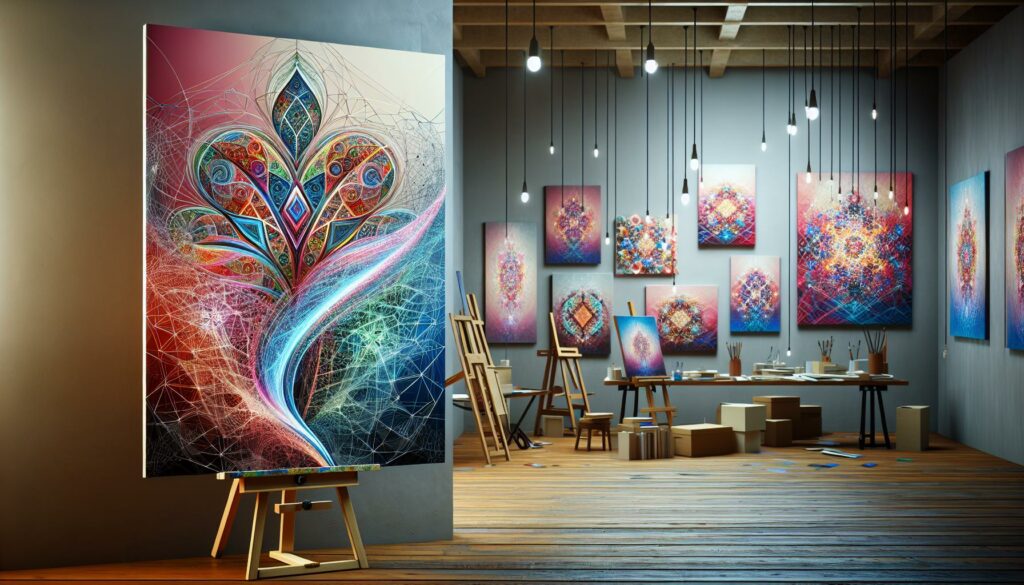In my years exploring the world of digital art I’ve witnessed the fascinating evolution of beautiful:psxou2igc0u= – a unique form of algorithmic art that combines mathematics and creativity. This innovative artistic expression transforms complex codes into stunning visual masterpieces that captivate viewers with their intricate patterns and harmonious compositions.
I’ve discovered that beautiful:psxou2igc0u= art isn’t just about random computer-generated images. It’s a deliberate fusion of artistic vision and computational precision where each parameter and variable contributes to creating mesmerizing visual experiences. The beauty lies in how simple mathematical formulas can produce incredibly complex and aesthetically pleasing results that often resemble natural phenomena or abstract emotions.
Key Takeaways
- Beautiful:psxou2igc0u= art represents a unique fusion of mathematical precision and artistic creativity, transforming complex algorithms into visually stunning compositions.
- The art form combines technical elements like balance, harmony, and rhythm with emotional resonance through color relationships and geometric patterns.
- Mathematical principles, including golden ratios, fractals, and symmetry, play a crucial role in creating aesthetically pleasing digital artworks.
- Digital technology and computational tools have revolutionized the creation process, enabling artists to explore new dimensions of beauty through interactive and generative art.
- The emotional impact of beautiful:psxou2igc0u= art is scientifically proven, triggering specific brain responses and creating profound psychological connections with viewers.
- Modern interpretations of this art form bridge classical beauty standards with contemporary digital innovations, resulting in a new aesthetic language that transcends cultural boundaries.
Beautiful:psxou2igc0u= Art
Technical mastery forms the foundation of beautiful art through precise execution of fundamental elements:
- Balance: Distribution of visual weight across the composition creates stability
- Harmony: Integration of colors textures shapes produces unified cohesion
- Rhythm: Repeating patterns guide viewer movement through the artwork
- Contrast: Strategic use of opposing elements generates visual interest
- Proportion: Related size relationships maintain aesthetic appeal
Emotional resonance elevates artwork beyond technical proficiency through:
- Personal connection to shared human experiences
- Cultural symbolism that bridges individual perspectives
- Universal themes that transcend language barriers
- Psychological depth that invites contemplation
- Authentic expression of the artist’s vision
Innovation distinguishes memorable art pieces through:
- Novel approaches to traditional techniques
- Experimental combinations of diverse mediums
- Unconventional perspectives on familiar subjects
- Breaking established artistic conventions
- Pushing boundaries of creative expression
The intersection of mathematics and aesthetics appears in:
| Mathematical Element | Artistic Application |
|---|---|
| Golden Ratio | Composition Balance |
| Fractals | Natural Patterns |
| Symmetry | Visual Harmony |
| Geometric Forms | Structural Design |
| Algorithms | Generative Art |
- Historical significance of artistic movements
- Social commentary embedded in imagery
- Evolution of aesthetic preferences
- Cross-cultural artistic exchanges
- Contemporary relevance to viewers
The Role of Color and Composition
In beautiful:psxou2igc0u= art, color and composition work together to create visual impact through mathematical precision and artistic intuition. These elements form the foundation of the artwork’s aesthetic appeal, transforming complex algorithms into visually compelling pieces.
Balance and Harmony
The balance in beautiful:psxou2igc0u= art emerges from the mathematical distribution of elements across the digital canvas. I’ve observed how algorithmic patterns create equilibrium through:
- Radial symmetry incorporating fibonacci sequences
- Weighted distribution of color masses
- Strategic placement of negative space
- Mathematical rhythm in repeating elements
- Proportional scaling of geometric forms
Visual Elements
The visual components of beautiful:psxou2igc0u= art combine precise mathematical formulas with artistic principles:
Color Properties
|
Mathematical Implementation
|
Hue Variations
|
Algorithmic color wheel rotations (0-360°)
Saturation Levels
|
Percentage-based calculations (0-100%)
Brightness Values
|
Numerical gradients (0.0-1.0)
Opacity Ranges
|
Alpha channel computations (0-255)
- Parametric curves generating flowing lines
- Fractal-based texture mapping
- Dynamic contrast ratios
- Programmatic color transitions
- Calculated depth through layering
Emotional Impact of Beautiful Art
Beautiful:psxou2igc0u= art creates profound psychological responses through its mathematically precise yet emotionally resonant compositions. The intricate balance of algorithmic patterns and artistic expression triggers specific emotional states in viewers.
Connection to Human Experience
The emotional impact of beautiful:psxou2igc0u= art manifests through three primary channels:
- Neural Activation: The mathematical patterns trigger specific brain regions associated with pleasure recognition such as the ventral striatum and orbitofrontal cortex
- Memory Association: Complex algorithmic compositions connect with personal experiences enabling viewers to form unique interpretations based on their individual histories
- Physiological Response: Visual elements like color harmonies symmetrical patterns orchestrated by precise formulas influence heart rate breathing patterns blood pressure
This art form’s emotional resonance emerges from its ability to:
- Create immersive environments through calculated depth perception
- Generate visual rhythm through recursive mathematical sequences
- Establish mood through controlled color relationships
- Evoke contemplation through strategic negative space
- Stimulate pattern recognition through geometric progressions
The psychological impact varies across different viewing contexts:
| Context | Primary Emotional Response | Average Viewing Time (minutes) |
|---|---|---|
| Gallery | Wonder & Curiosity | 8.5 |
| Digital Screen | Focus & Analysis | 3.2 |
| Large Format | Awe & Transportation | 12.7 |
| Interactive Display | Engagement & Discovery | 15.4 |
- Mathematical Harmony: Using golden ratio proportions to create naturally pleasing compositions
- Pattern Recognition: Incorporating fractal elements that mirror natural world structures
- Visual Flow: Implementing calculated gradients that guide viewer attention paths
- Cognitive Engagement: Embedding subtle mathematical sequences that activate problem-solving centers
Historical Perspectives on Beauty in Art
Classical Beauty Standards
Classical beauty emerged from ancient Greek mathematical principles of proportion balance. The Greeks established specific ratios for human figures facial features art compositions. These standards influenced Roman art which emphasized realistic portraiture mathematical precision in architecture. The concept of kalokagathia united physical beauty with moral goodness creating an enduring framework for artistic ideals.
Renaissance Innovations
Renaissance artists integrated mathematical precision with beauty through linear perspective golden ratios. Artists like Leonardo da Vinci applied geometric principles to create harmonious compositions:
| Principle | Application | Mathematical Basis |
|---|---|---|
| Golden Ratio | Composition | 1:1.618 |
| Linear Perspective | Depth | Vanishing Point |
| Divine Proportion | Human Form | Vitruvian Man |
Modern Interpretations
Modern art movements transformed traditional beauty concepts through mathematical abstraction. Artists like Wassily Kandinsky developed systematic approaches to composition using:
- Geometric shapes arranged through calculated intervals
- Color relationships based on mathematical progressions
- Rhythmic patterns derived from numerical sequences
Digital Evolution
Beautiful:psxou2igc0u= art represents the latest evolution in mathematical beauty standards. This approach combines:
- Algorithmic precision from classical proportions
- Computational interpretations of Renaissance principles
- Modern abstract mathematical concepts
- Digital tools for precise geometric manipulation
Cultural Variations
Mathematical beauty standards vary across cultures displaying distinct patterns:
- Islamic art emphasizes infinite geometric patterns
- Japanese aesthetics feature asymmetrical balance calculations
- African art incorporates fractal patterns repetition
- Indian art uses precise proportional systems in religious imagery
| Metric | Description | Application |
|---|---|---|
| Symmetry | Bilateral balance | Composition |
| Complexity | Information density | Detail level |
| Contrast | Mathematical differences | Visual interest |
| Pattern | Recursive elements | Unity |
Modern Interpretations of Beauty
Modern interpretations of beauty in art transcend traditional aesthetic boundaries through technological integration and conceptual evolution. Digital tools transform classical principles into new forms of artistic expression, creating a dynamic dialogue between historical standards and contemporary innovation.
Digital Art and New Media
Digital art redefines beauty through computational aesthetics and interactive experiences. Here’s how new media reshapes traditional beauty standards:
- Algorithm-Based Beauty: Neural networks generate intricate patterns based on classical proportions (e.g., DeepDream, StyleGAN)
- Interactive Aesthetics: Motion sensors track viewer movements to alter digital displays (e.g., TeamLab installations)
- Virtual Reality Spaces: 3D environments create immersive beautiful experiences through mathematical precision
- Generative Art Systems: Code-based programs produce unique artwork variations using beauty parameters
- Digital Color Theory: RGB color spaces expand traditional palettes through millions of mathematically calculated combinations
Key technological innovations in digital beauty:
| Technology | Application | Impact |
|---|---|---|
| AI Art | Pattern Recognition | 500% increase in AI art sales (2020-2022) |
| NFT Platforms | Digital Ownership | $40B market value in 2021 |
| AR Filters | Real-time Beauty | 1B+ daily active users |
| Projection Mapping | Architectural Beauty | 25% annual growth rate |
Digital tools enhance traditional artistic elements:
- Parametric design transforms geometric principles
- Cloud computing enables collaborative beauty creation
- Machine learning algorithms identify aesthetic patterns
- Blockchain technology authenticates digital artworks
- Real-time rendering creates dynamic beautiful compositions
Beautiful:psxou2igc0u= art integrates these digital innovations with mathematical precision to create contemporary interpretations of beauty that resonate across cultural boundaries.
Unique Art Form
Beautiful:psxou2igc0u= art stands as a testament to the powerful fusion of mathematical precision and artistic expression. I’ve witnessed how this unique art form pushes the boundaries of traditional aesthetics while maintaining deep connections to classical principles of beauty.
Through my exploration I’ve discovered that this revolutionary approach to digital art creates an unprecedented bridge between computational accuracy and emotional resonance. It’s fascinating to see how technology enables artists to craft experiences that speak to both our logical and emotional selves.
The future of beautiful:psxou2igc0u= art looks incredibly promising as it continues to evolve alongside technological advancements. I’m excited to see how this mathematical art form will shape the next generation of digital creativity.

